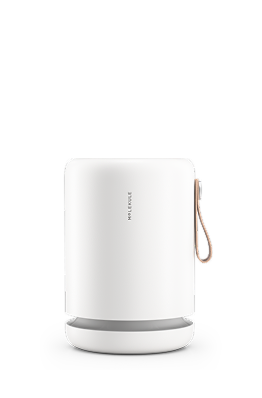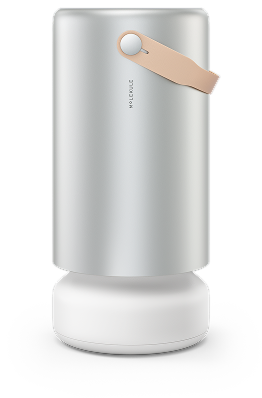Some of the greatest public health problems have involved contaminants that cannot be seen with the naked eye, including John Snow’s triumph against the bacterium Vibrio cholerae in polluted drinking water. However, what about pollutants in the air? Except in the case of smoke and smog, we cannot see air contaminants, either. They may also be residing alongside us, without our knowledge, causing mysterious health effects or aggravating conditions like allergies and asthma. Fortunately, we can do something about the hidden pollutants in our homes.
Biological Pollutants
The EPA describes biological pollutants as either living themselves or produced by living organisms, and many are usually small enough to be inhaled.
A typical list of biological contaminants include:
- Mold spores spread through the air
- Bacteria brought inside by people, animals, soil, and plant material
- Viruses spread from person to person through droplets in the air
- Pet dander (skin flakes) and saliva that get stirred and suspended into the air
- House dust mites present in mattresses, bedding, or carpet
- Pollens originating from plants
Biological pollutants come from many different sources and can be found in areas where food or moisture are present. One breeding ground for mold and other pollutants is a contaminated central air handling system that can disperse these contaminants throughout the inside air.
Mold is a particularly tricky biological pollutant. Though you can see the source, you cannot see the mold spores that spread through the air. The EPA describes these spores as invisible to the naked eye, which float through the indoor and outdoor air. The key is that mold spores cannot grow without moisture. Since mold likes to grow in damp conditions, it can usually be found where humidity levels are higher in the home. These areas can include basements, showers, bathtubs, or sinks.
What are the health effects of biological pollutants?
The EPA says that children, older adults, and those with breathing problems, allergies, and lung diseases are especially vulnerable to biological air pollutants that cause disease. Allergic reactions occur only after repeated exposure to a specific biological allergen, yet the response can happen upon a single re-exposure or after multiple re-exposures. Also, mold, dust mites, and dander can trigger asthma. Lastly, diseases like tuberculosis, measles, and influenza can be transmitted through the air.
Symptoms of health problems caused by exposure to biological pollutants include:
- Watery eyes
- Shortness of breath
- Coughing
- Dizziness
- Fever
- Digestive problems
The Centers for Disease Control and Prevention (CDC) reports that in the case of mold, symptoms of health problems due to exposure can include:
- Nasal stuffiness
- Eye irritation
- Wheezing
- Skin irritation
People who are exposed to large amounts of mold on a consistent basis, or who have severe mold allergies, will experience more severe reactions such as fever and shortness of breath.
How do I reduce levels?
It is impossible to have your home free of all these pollutants at all times. However, here are some tips from the EPA to help limit and reduce exposure to these contaminants:
- Keep your house clean – Even though mold, dust mites, pollens, dander, and other biological pollutants cannot be eliminated, they can be reduced over time. Suggestions include vacuuming (when allergic individuals have left the house, because of the temporary increase in airborne levels during vacuuming), washing sheets in hot water, cleaning and drying water-damaged carpet, and using impermeable allergen mattress and pillow covers. By taking these steps, you can reduce the levels of these pollutants.
- Ventilate your attic and home to reduce moisture – Using exhaust fans in the kitchen and the bathroom and keeping the humidity levels below 50 percent in attics and crawl spaces can reduce water condensation on building materials. It is also essential to ensure proper ventilation throughout the home so that humidity does not build up and become an ideal environment for mold and dust mites. Moisture control is the best way to slow mold growth, and you can also use a dehumidifier during high humidity months.
- Clean appliances such as humidifiers, air conditioners, and refrigerators – Humidifiers and other appliances that become damp can become areas where biological pollutants thrive.
- Be wary of where carpets go – Carpets should never be placed in bathrooms, where moisture builds up over time and leaves carpeting susceptible to mold growth. Also, always try to remove or replace carpeting that becomes soaked so that mold cannot grow.
Formaldehyde
According to the EPA, formaldehyde is a colorless, flammable gas (a volatile organic compound, or VOC) that has a strong odor and can cause various health effects. It is most commonly found in:
- Composite wood products like particleboard
- Household products like glues, paints and coatings, and lacquers and finishes
- Building materials and insulation
- Preservatives present in some cosmetics, medicines, and other consumer products
What are the health effects of formaldehyde?
The most common way a person is exposed to formaldehyde is when it is off-gassed or released into the air, such as from composite wood products.
The EPA reports that exposure to formaldehyde can lead to some cancers (from high levels of exposure) and cause irritation of the skin, eyes, nose, and throat.
How do I reduce levels?
The Agency for Toxic Substances and Disease Registry (ATSDR) recommends:
- Reducing levels of formaldehyde already present in your home through opening windows (if possible and safe), using exhaust fans, and making sure your home is smoke-free
- Selecting products for your home with low or zero formaldehyde (for example, you can look for products labeled “No VOC/Low VOC”)
- Reducing formaldehyde levels from new products by washing permanent-press clothes and curtains before use, and letting new products release the chemical outside the home before you use them
Asbestos
According to the U.S. Consumer Product Safety Commission (CPSC) and the U.S. Environmental Protection Agency (EPA), asbestos is a mineral fiber that is found in rock and soil and often has been used in many different building construction materials for insulation and as a fire-retardant. The EPA and the CPSC have banned the use of asbestos in some instances, but most asbestos uses are not prohibited at the federal level.
Commonly found in older homes, asbestos can be present in many materials. Though in more recent times manufacturers have elected to limit uses of asbestos, the EPA reports that it has been used in a range of manufactured goods. Most commonly it appears in building construction materials like roofing shingles, friction products like an automobile clutch, heat-resistant fabrics, packaging, gaskets, and coatings. Other places asbestos can be found are hot water and steam pipes, attic and wall insulation, textured paint and patching compounds, and vinyl floor tiles.
If your home may contain asbestos, the EPA and CPSC say not to panic! It is better to leave good-condition asbestos material alone because generally, it will not release asbestos fiber. Only if fibers are released into the air and inhaled into the lungs can it be harmful.
What are the health effects?
When material that contains asbestos is disturbed through product use, demolition work, home maintenance or repair and remodeling, its fibers and particles can be released into the air and inhaled.
The CPSC and the EPA say that the most harmful asbestos fibers are too small to be seen, and after they are inhaled, can enter and accumulate in a person’s lungs. The majority of people with illnesses related to asbestos were exposed to increased concentrations of asbestos while on the job, and some developed disease from asbestos found on clothing and equipment brought back from job sites. Disease symptoms can take years to appear after asbestos exposure.
The EPA reports that the three significant health effects are lung cancer, mesothelioma, and asbestosis. Asbestos exposure can increase your risk of lung disease and this risk increases with smoking. Disease symptoms can take years to appear after asbestos exposure. The symptoms of mesothelioma cancer, unfortunately, do not fully show themselves for 20 to 40 years, when the disease has already entered the last stage.
How do I reduce my exposure?
The CPSC and the EPA advise that asbestos-containing material that is not damaged should be left alone, not disturbed or touched, and periodically checked for deterioration. They recommend against cutting, ripping, or sanding such material. If you will be making changes to your home, and the material containing asbestos is more than slightly damaged, then professional repair or removal is required. If you need to clean up or remove the material, it is best to call a professionally trained contractor.
Radon
The Centers for Disease Control and Prevention (CDC) describes radon as a naturally occurring gas that forms when radioactive metals break down in rocks, soil, and groundwater. The primary way for us to be exposed is from breathing radon in the cracks and gaps in our homes. One cannot see, taste, or smell radon, and it can become a problem in any home.
According to the CDC, radon can enter your home through many ways, including:
- Cracks in floors and walls
- Gaps in suspended floors
- Gaps around pipes
- The water supply
- Construction joints
What are the health effects?
The CDC reports that when a person breathes in radon, the radioactive particles become trapped in the lungs and that over time, these particles increase the risk of lung cancer. According to the EPA, radon is the second leading cause of lung cancer. It is estimated that about 20,000 lung cancer deaths a year are due to radon, second after cigarette smoking. Also, people who smoke and are exposed to radon have an even higher risk of developing lung cancer.
How do I protect myself and my family?
Testing for radon in your home is the only effective way to see if you and your family are at risk for high levels of radon exposure. Testing for radon is both inexpensive and easy.
- Buy a test kit – Testing should only take a few minutes and involves placing a small measuring device in a room of your home and leaving it for the desired time, either a short-term period (a few days to 90 days) or a long-term period of over 90 days. The longer the duration of the test, the more relevant the results will be.
- Mitigation – If the test reveals high radon levels, the EPA recommends that you work with a qualified radon mitigation contractor to fix your home, as it requires proper equipment and technical knowledge and skills.
The urgency of addressing problems that we cannot see with our eyes or smell with our noses is often disregarded. However, the risk of indoor air pollution is something that we cannot ignore. Fortunately, there are steps we can to take to combat the invisible pollutants that are often hidden within our homes, thus reducing our exposure and creating a safer, healthier environment.







